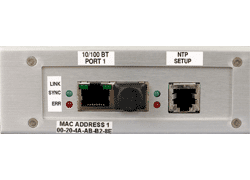Options - Option 32 Internal Network Time Protocol (NTP) Server -DISCONTINUED-
Summary Information
Provides a GPS-synchronized, stratum level 1, network time protocol (NTP) server with one (Option 32) or two (Option 33) 10/100Base-T Ethernet connector(s). Available on Models 1084, 1088 and 1093.
Full Description
-DISCONTINUED-

Internal Network Time Protocol (NTP) Server, as installed on rear of chassis.
The Internal Network Time Protocol Server option allows an Arbiter Systems®, Inc. GPS Satellite-Controlled Clock to act as a time server over an Ethernet network using the Network Time Protocol (NTP). Operating as a primary or stratum 1 server (symmetric operation modes are not supported), time is distributed to connected systems, such as workstations, PCs, servers and routers via the Ethernet interface. The Internal Network Time Protocol Server understands NTP version 1, version 2 and version 3 frames while optionally supporting authentication via DES and MD5 cryptographic checksums. Typical accuracy for the NTP server is a few milliseconds on a LAN to a few tens of milliseconds on a WAN as compared to UTC (Coordinated Universal Time); accuracy will vary depending upon network traffic.
Principles of Operation
Synchronizing a client to a network server consists of several packet exchanges where each exchange is a pair of request and reply. The client stores its local time into the packet being sent. The server receives the packet and then stores its own estimate of the current time into the packet and returns the updated packet. The client receives the updated packet and will once more log its own receipt time to estimate the travelling time of the packet. These time differences are used to estimate the time it took for the packet to be transmitted from the server to the requestor. That round-trip time is taken into account when estimating the current time. The shorter the round-trip time, the more accurate the estimate of the current time. It takes several packet exchanges before the client believes the server time is correct. Only when the replies from the server satisfy the conditions defined in the protocol specification, is the server considered valid. Time cannot be synchronized from a server that is considered invalid by the protocol. Multistage filters are used to estimate the quality of the time samples. Usually it takes about five minutes (five good samples) until an NTP client is synchronized to a server.
The quality estimate of a client, obtained using multistage filtering, usually improves over time. If the client has a more accurate estimate than a server, such a server may be considered invalid after some time.
Time can be passed from one time source to another, typically starting from a reference clock connected to a stratum 1 server. Servers synchronized to a stratum 1 server will be stratum 2. Generally the stratum of the server will be one more than the stratum of the reference.
Available on Models 1084, 1088 and 1093.
Specifications:
Performance:
- Accuracy: Less than one microsecond, depending on network load and clock accuracy
- Management: Serial and Telnet login
System Interface:
- Network: Two (2) RJ45 (10/100Base-T)
- Compatibility: Ethernet Version 2.0/IEEE 802.3
- Protocols: IP-ARP, UDP, ICMP, SNMP, TCP, TFTP, NTP
- Serial RS-232: 1200 baud to 19200 baud; 7 or 8 data bits; 1 or 2 stop bits; even/odd/no parity; RJ11 connector
Operator Interface:
- Status LEDs: Synch (green), Fault (red), Link (green)
- Setup: IP number, Net Mask, Gateway, UDP Broadcast parameters (port, interval, up to eight target addresses), MD5 and DES authentication keys are optional
